

Biological Clocks in Mosquitoes - Section 2
|
(a) The simplest explanation
In a previously unpublished experiment, Ae. aegypti females reared wholly in LL (5-6 days old at the start) were recorded for three days in LL before an LD 12:12 regime was started.
Figure 21 shows how an apparently unentrained set of individuals was immediately entrained by light-off to give an activity rhythm with the observed maximum in the half-hour before the next light-off, i.e. an E' peak.
Figure 21

The entraining effect of light-off also can be seen in Figure 22, which shows the activity of other females reared and recorded in LL before the lights were switched off to give DD.
Figure 22

The initial effect of the transition is a depression of activity but on the second day the activity starts to show a pattern of peaks and troughs, with the larger rises occurring at a frequency of somewhat less than 24h. At this point one could be led to accept a simple single clock explanation for the fundamental cycle of daily flight activity.
In Figure 23, a sine wave, plotted with its maximum level at the point of light-off and t = 24h, is overlaid on the histogram of the activity shown in Figure 21. This sine wave is referred to as the "OFF SINE" hereafter.
Figure 23

Because the activity histogram in Figures 21 and 23 shows a slightly more pronounced M peak than is usual for the LSHTM strain, the histogram shown in Figure 24a will be used from here on. By modulating the plot of the sine wave, the OFF SINE concept can be further developed, and the adoption of a five-fold increase in amplitude during the L sector, Figure 24b, shows a good fit between the modulated wave and the actual E' activity. Although this produces an apparently realistic simulation of the observed activity pattern, it could well be that the modulation is a simulation of the potential for activity rather than a simulation of the output of the clock itself.
Figure 24
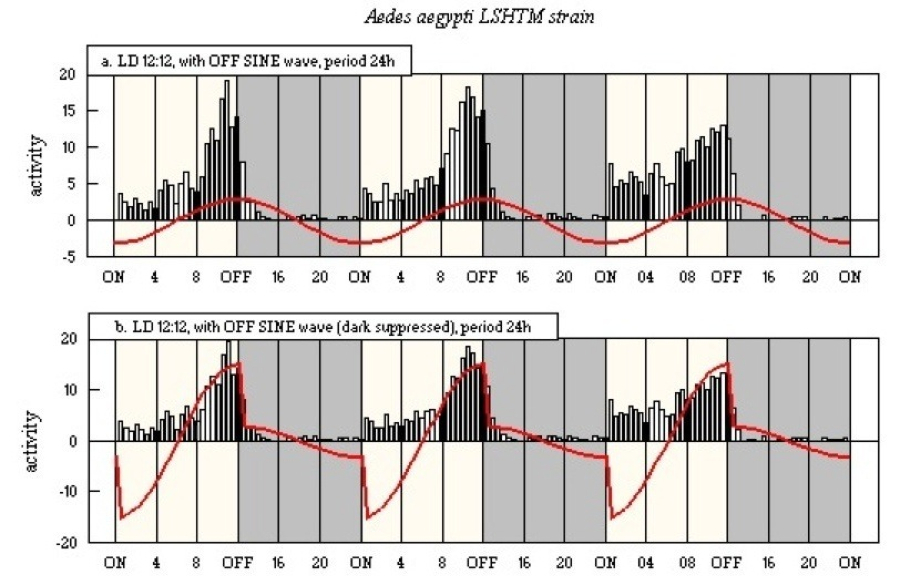
The LD 12:12 activity pattern shown in Figure 21 is clearly bimodal, however, with a sharp M peak and declining lower level activity for the next two to three hours. It could be that the M peak is no more than a startle response but the continuation of activity, albeit at a lower level, suggests that M is a true reflection of a underlying rhythm (this is supported by Figure 24, and by further evidence later in the text). The fact that M occurs after the first D period indicates a second manifestation of light-off entrainment, but by itself the simple OFF SINE clearly cannot accommodate such an M peak.
One possibility could be that the OFF SINE has a frequency of t = 12h and not t = 24h. This is plotted in Figure 25, again with a variation between amplitude in L and D.
Figure 25
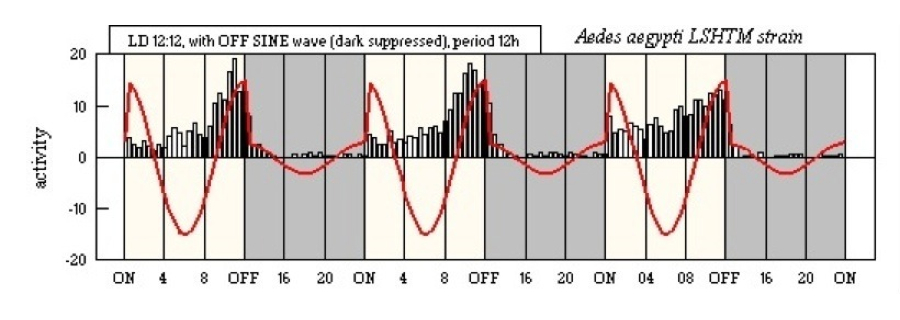
The t = 12h frequency will give a bimodal pattern but this is much narrower than the actual activity pattern and, therefore, does not offer a good model. A more viable alternative is to suggest a second light-off entrained sine wave, also with t = 24h but running in antiphase to the OFF SINE.
This "OFF ANTISINE" is plotted in Figure 26 (again with an amplitude variation in L and D) in addition to the modulated OFF SINE.
Figure 26
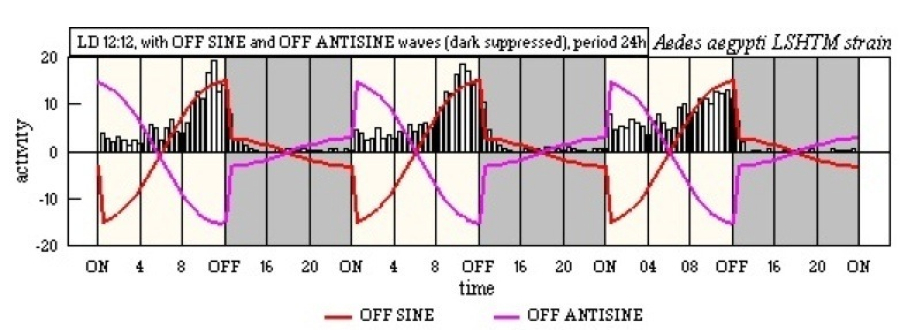
The evidence at this point, however, is ambiguous - there may be two controlling, or gating, systems from one clock or there may two separate clocks.
The assumption so far has been that the underlying rhythmicity of the clock, or clocks, has a periodicity of t = 24h. This would not require any clock resetting mechanism as there is no deviation from the natural 24h solar day. It, however, is an incorrect assumption as, in common with the majority of other living organisms, the periodicity of Ae. aegypti activity in constant conditions of light or dark deviates from t = 24h, and with only small variation between individuals.
This is illustrated in Figure 27, with the OFF SINE and OFF ANTISINE also plotted; in LL t @ 26h (see Figure 27a) and in DD t @ 22.5h (see Figure 27b).
Figure 27
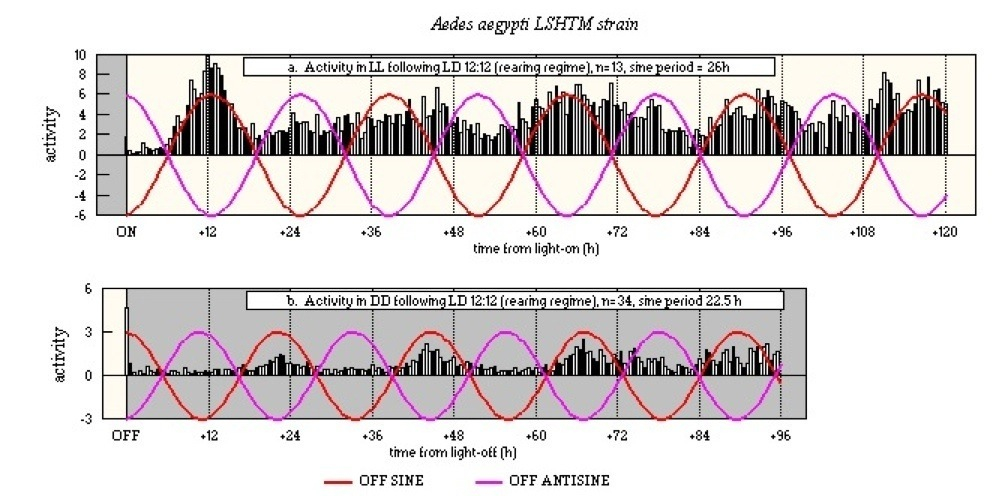
Other authors have shown that there are species-specific thresholds of illumination in insects and that changes in illumination do not act by a gradual process but in an "all-or-nothing" manner. It seems quite reasonable, therefore, to suggest that the apparent periodicity of t = 24h observed in LD 12:12 is actually the product of the clock, or clocks, running faster in darkness and slower in light.
In geometric terms and assuming that the clock mechanism, or oscillator, is cyclic, t = 22.5h would mean a speed of 16° per hour, whereas t = 26h would mean a speed of only 13.85° per hour. In LD 12:12, the progress, commencing from light-off, would be 12 X 16° = 192° in D, plus 12 X 13.85° = 166° in L; the total of 358° obviously is only shorter than the full 360° by a very small amount. The level of resetting, or entrainment, is equally minute. Nevertheless, it can be seen that there is a change in the shape of the sine wave and a requirement for the clock, or clocks, to be reset, or entrained. This will be returned to later.
The incorporation of speed change from D to L, and so-on, is illustrated in Figure 28. The OFF SINE is plotted adjusted upwards at light-off to restart at the apogee (3.0 in D), and the OFF ANTISINE is shown adjusted downwards to restart at the perigee (-3.0 in D). To better simulate the actual activity, in L the OFF ANTISINE is plotted with a lower amplitude (maximum 9.0) than is used for the OFF SINE (maximum 15.0).
Figure 28
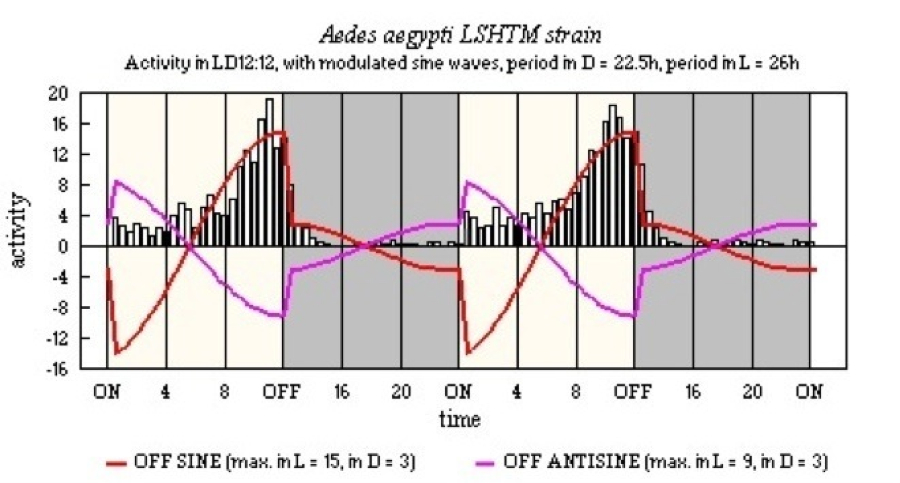
Although the paired OFF SINE and OFF ANTISINE system offers what seems to be a satisfactory mechanism for the Ae. aegypti flight activity pattern in LD 12:12, experiments using asymmetric LD regimes showed patterns which this system could not fully meet. The most remarkable of such experiments was that in which the LD regime was changed from LD 12:12 to LD 20:4 by advancing the time of light-on. This is illustrated in Figure 29, with the OFF SINE and OFF ANTISINE waves overlaid (with both amplitude modulation and light:dark speed changes incorporated).
Figure 29
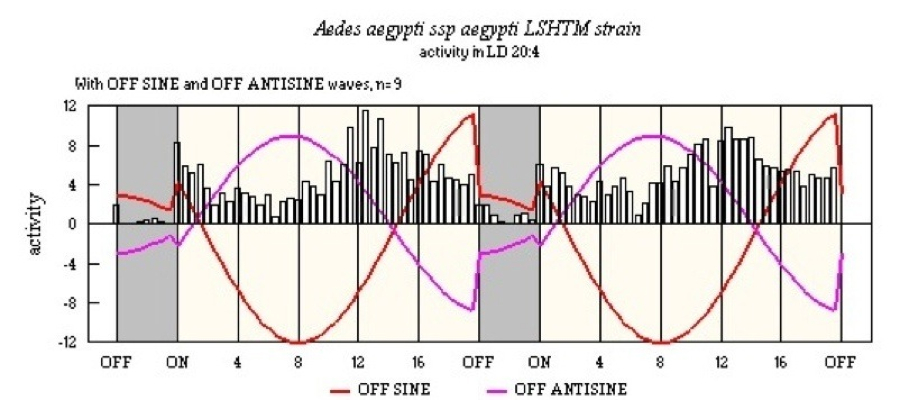
The major peak of activity was found to have moved forward in the very first of the early light-on days and the peak remained at the advanced position in all the subsequent LD 20:4 cycles. This position of the main peak some 13-14h after light-on was consistent and occurred in all experiments with LD 20:4 regimes, including several where the mosquitoes were reared wholly in the regime. Clearly the light-off entrainment alone could not account for the actual activity pattern and, so, it was concluded that entrainment by light-on also was involved.
To simulate how this dual entrainment might act the concept is enlarged to include paired "ON SINE" and "ON ANTISINE" waves. These are shown in Figure 30, as well as the OFF pair, and it can be seen that the additional ON-entrained clocks show a good match with the actual activity.
Figure 30

The validity of this system of two clocks, each with two controlling functions, or of four clocks, two responsive to an upward passage of a threshold light intensity (light-on) and two responsive to a downward passage of a threshold light intensity (light-off), gains support from the experiments shown in Figure 31.
Figure 31
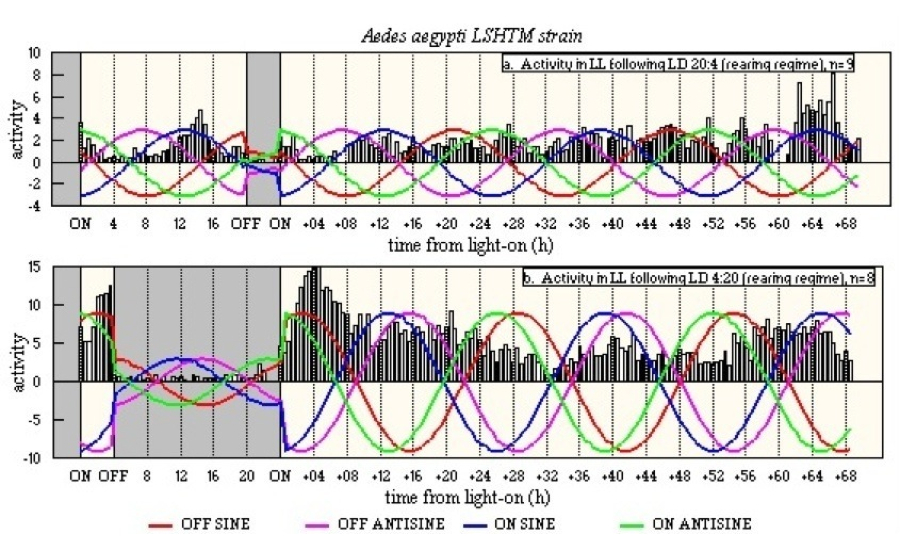
In these, the mosquitoes were reared wholly in LD 20:4 (see Figure 31a) or in LD 4:20 (see Figure 31b) and then, after a short period of recording in the rearing regime, were recorded in LL. The majority of changes in level of activity in the constant conditions can be seen to be matched by a change in one or other of the postulated sine waves.
Two problems encountered in many studies of insect circadian rhythms need to be kept in mind. First is the relatively short life of the insects. Ae. aegypti is no exception and it was found early in the studies that pre-death bursts of activity were not uncommon. This was reduced by providing both sugar solution and free water for feeding but still remained a low-key problem in longer duration experiments, occasionally leading to spurious peaks in the histograms of mean activity. The second is the fact that one is comparing the activity of living organisms, with inherent variability in performance, with absolutely regular mathematical models.
The observed activity pattern in LD 12:12 is returned to in Figure 32.
Figure 32
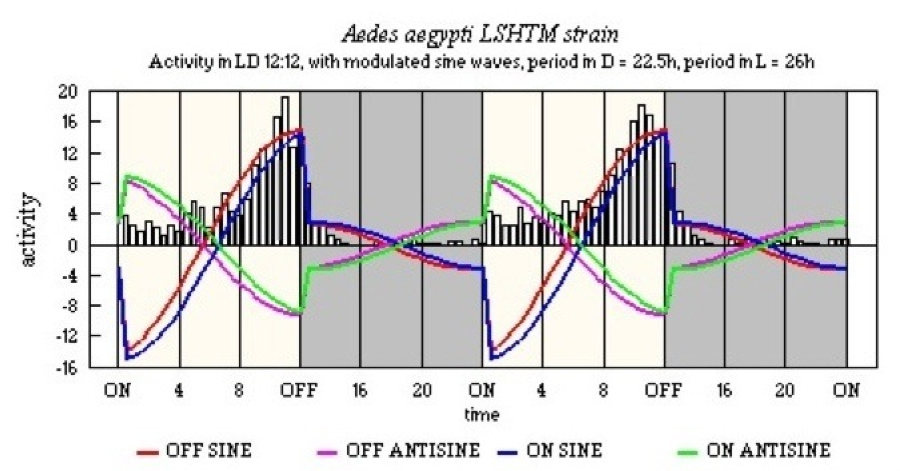
Here the full complement of four sine waves is shown, with amplitude modulation, speed adjustment between L and D, and the appropriate entrainment by light-on and light-off. The proposed system now shows how the clocks can be separated by the light-on and light-off entrainment, and that this separation can lead to more numerous fluctuations in the activity pattern. The earlier illustration of activity when LD 12:12 was followed by LL (see Figure 27a) shows that indeed this is the case, with particularly obvious rises in activity when both the OFF SINE and OFF ANTISINE waves are at zero and would not be expected to stimulate (or permit) activity.
The histogram from Figure 27a but with the four sine waves overlaid is shown Figure 33. Even though there is not much separation between each member of the pairs of SINE and ANTISINE waves, the resultant broader activity framework does account for most, but not all, of the observed activity.
Figure 33

A final use of Ae. aegypti data to test the validity of the system is the circadian rhythm recorded in DD. This has not been used in the foregoing development of the concept, as the levels of activity in DD are low and tend to be susceptible to "noise", particularly because of factors related to the physiological state of the mosquitoes (such as the age of the individuals, see the note on pre-death bursts of activity above). Activity histograms from three experiments using DD following LD 4:20 are shown in Figure 34.
Figure 34
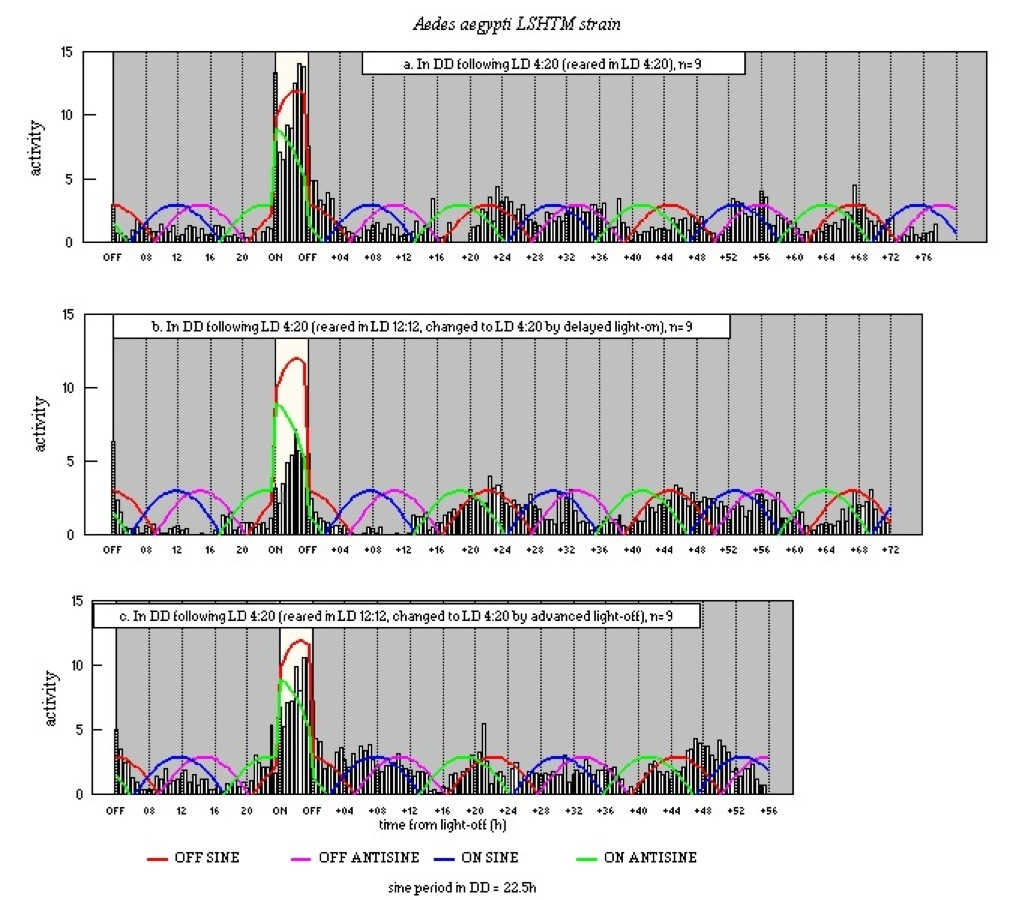
These experiments used mosquitoes which were reared in LD 4:20 (Figure 34a); were reared in LD 12:12 and the regime changed to LD 4:20 by delaying light-on (Figure 34b); or, were reared in LD 12:12 and the regime changed to LD 4:20 by advancing light-off (Figure 34c). To make visualisation easier, in these graphs only positive values were plotted for each of the four sine waves. The activity pattern in DD is very similar in all three histograms, with almost all rises in the observed activity being mirrored by an apogee of one of the postulated sine waves.
The concept as applied to five LD regimes is presented in Figure 35. Again, only positive values were plotted for each of the four sine waves.
Figure 35

The evidence so far suggests that:- Even in median LD regimes (such as LD 12:12), simple light-off entrainment requires two clocks to control the timing of the bimodal daily activity patterns. The speed of operation of each clock appears to affected by the intensity of illumination, but there are only two speeds - one when light intensity is above a threshold and the other when light intensity is below the threshold. In Ae. aegypti the speed, or periodicity, for a complete 360° cycle is t @ 26h in high light (L), and t @ 22.5h in low light (D). The use of asymmetric LD regimes (especially the more extreme LD regimes, such as LD 4:20 and LD 20:4) shows that the light-on and light-off effects can be further split, with peaks of activity away from the normal peaks at dawn and dusk, and there may actually be four clocks operating. In a stable LD regime, the upward transition of the light intensity threshold entrains the light-on clocks, by restoring the oscillator level to the maximum deviation (upwards or downwards, as appropriate), and the downward transition entrains the light-off clocks.
|
©1998, 2010 - Brian Taylor CBiol FSB FRES 11, Grazingfield, Wilford, Nottingham, NG11 7FN, U.K. Comments to dr.b.taylor@ntlworld.com |